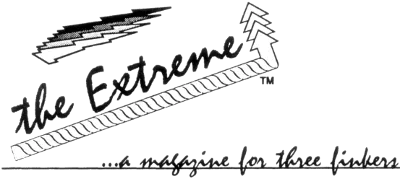


Andersen Silva: Editor-in-chief
Derek R. Iannelli-Smith: Associate editor
Barbara redacted: Movie critic
Jon Wardell: Graphic artist
Grace Silva: Photographer
Martin Rivas: Serious Pilgrim liaison
Paul D.Q. Campbell: Technical writer
Liz Kassler, Dave A. Law, Valerie Donovan: Contributing editors
Last updated 6-28-2022
Andersen Silva began considering the creation of his own publication in November 1994, a showcase for others' writing in addition to some of his own. The name came from a line in the black comedy "Heathers": "The extreme always seems to make an impression." Phone calls to two of his best friends netted him a movie critic and a graphic artist, and his sister soon agreed to be the fledgling 'zine's photographer.
Posting on American Online and some Usenet newsgroups resulted in more than a few literary submissions. The indie Staten Island band Serious Pilgrim, of whom Andy was a fan, accepted his offer of a regular column in the 'zine and asked him to review their recently-released eponymous debut album.
Which he did when the Extreme debuted in January 1995, with the subtitle "...a magazine for three finkers." At 32 pages (except for the June 1995 issue, which blew up to 44 pages), the monthly digest-sized publication was a little ambitious but did deliver short fiction and poetry and columns, from people like Paul D.Q. Campbell, Sheri Tacker, Robert Klein Engler, Valerie Donovan, Ben Ohmart, Cheryl A. Townshend, Dave A. Law, Miranda R. Walters, Peter Quinones, and more. While some copies and subscriptions were sold, submissions ended up coming in much faster than any money.
The 'zine printed columns on bug jewelry, a new sound-producing fishing lure, and celebrities abusing their right to free speech; erotic fiction and poetry (one story that flirted with bestiality prompted a columnist to demur from further collaboration with the Extreme); band interviews; and numerous reviews of known and unknown movies, two restaurants, and, eventually, a travel book and several albums and EPs. Music reviews were never part of the plan (other than the one for Serious Pilgrim), but something about publishing a 'zine, even if presented as a lit-'zine, makes one a magnet for indie musicians and labels. Andy subsequently received and reviewed releases by Gary Tanin, Vowel Movement, Fear of Falling, Body Clock, Dystopia1, Terminal Sect, Stratton, the Falling Wallendas, Urchins, and Haze.
Lurking in the alt.zines newsgroup exposed Andy to some petty squabbling, and convinced him that if there was some kind of 'zine "scene," he was not part of it. Still, the Extreme exchanged copies with some other 'zines, and received reviews in Factsheet Five #56 (the Extreme Vol. 1, No. 2) and Punk Planet #9 (the Extreme Vol. 1, No. 5) ("All of it's well written and put together very neatly and professionally. Good night reading"). Then he heard about the upcoming second annual Underground Press Conference at Chicago's DePaul University.
While the very concept seemed to invite mockery, Andy decided to head to Chicago for the three-day event in mid-August 1995. At the International Gallery of Zines the first night, he met Heath Row of Karma Lapel, with whom he'd exchanged a few E-mails/newsgroup posts before Chicago. Andy was introduced to Jack Csiki of Angelz & Rebelz and Jason Pramas of As We Are, and a compilation 'zine named Just About 10 PM Somewhere In Chicago was thrown together at Kinko's by Row, Pramas, Silva, and a fourth 'zinester.
Andy attended three panel discussions at the conference on Saturday, and went to the Saturday Night Underground Ball at the Bop Shop in bondage pants and Doc Martens, immersing himself more in the free literature scattered around than in the music of Jenny Magnus and the Vulva Club before leaving to be briefly harassed by some 'living rednecks' on the way back to the hotel. Sunday saw a spoof of the conference's official program bend some people out of shape, serving to reinforce Andy's misgivings about any 'scene' or unity amongst 'zine publishers overall. The review of the Extreme Vol. 1, No. 2 in the UPC's conference edition of U-Direct, which oscillated between attacking and admiring Andy's attempts to protect the works published therein, also left a sour taste.
While the 'zine had recently acquired Derek Iannelli-Smith as an associate editor to help handle the swelling tide of submissions, neither he nor anyone else was making any money off the publication, and Andy felt simultaneously overwhelmed and disillusioned, particularly after Chicago. Although they already had enough material to put out at least a couple of more issues, Vol. 1, No. 8, published in August 1995 before the UPC, would unexpectedly be the Extreme's last.